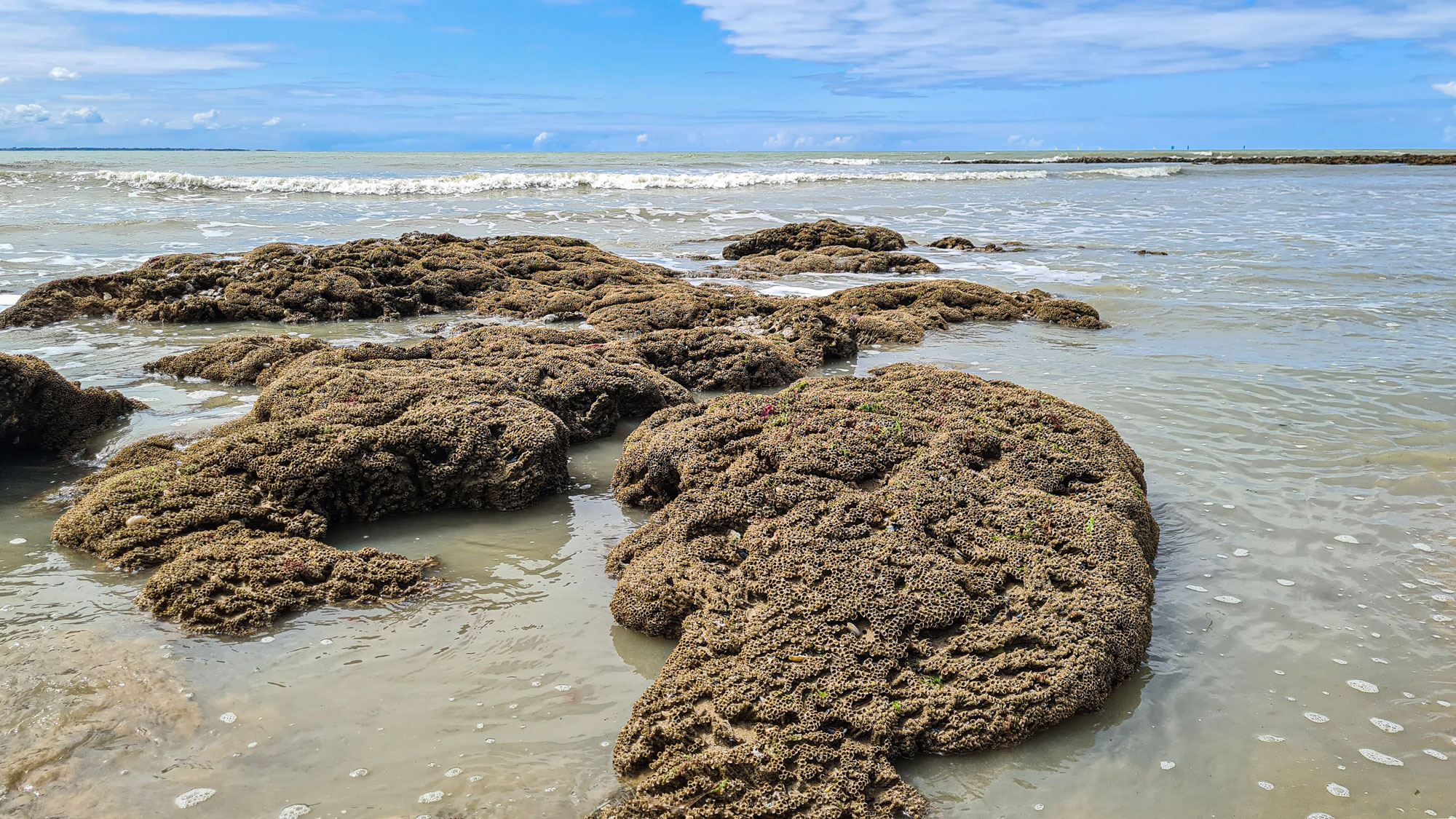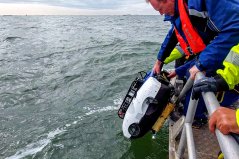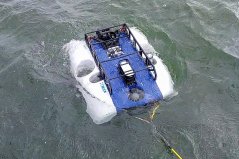
Background
A worm colony in the Wadden Sea
A small, bristly worm living in a tube of sand would be a rare sight in the Wadden Sea these days. But there was a time when these creatures built huge reefs teeming with life. Marine ecologist Martin Baptist is trying to restore the biodiversity of the Wadden Sea by giving the Sabellaria worm a chance to re-establish itself.
It’s a sunny Monday in September, and Martin Baptist of Wageningen Marine Research has finally decided to give it a go: off the coast of the Texel village of Oudeschild, he’ll be joining divers in their search for an unusual marine animal. “It’s been a tense wait all summer, because we needed the wind to drop to almost nothing for several days. Only then would the water be clear enough to see the seabed. This morning, the wind picked up again, but fortunately we still had time.”
Voor natuurlijke riffen heb je biobouwers nodig die zelf grote structuren maken.
Baptist is looking for Sabellaria worms, which can establish themselves under water there in the hard gully walls of the Texelstroom marine channel. The creature, also known as the Ross worm, uses sand to build its own little house. The worms stick their tubular houses together, thus creating a large underwater structure: a reef. That’s why they’re known as Sandkoralle in German.

The divers were unlikely to find a sand coral reef, but there was a chance of spotting the odd worm. And they’d be able to determine whether it would be a good place for the worms to live. At the very least, it was known to be a site with a hard substrate, located a few metres underwater and with lots of sand flowing past. Expectations were high. “It turned out to be a beautiful natural environment. Our divers saw polyps, sponges and sea squirts. But the stones of this gully wall were overcrowded with marine life. There was no more room for Sabellaria here.”
Ecosystem engineers
The gully wall of the Texelstroom marine channel is reinforced with stones and forms an artificial reef of some 20 hectares. Artificial reefs have been made in other parts of the Wadden Sea too, using concrete tubes, for example. “Their purpose is to restore the original natural environment of the Wadden Sea,” says Baptist. “These areas attract all sorts of creatures. But for me, genuine restoration means natural reefs, rather than concrete tubes. Natural reefs grow and then crumble, creating a dynamic system. Such reefs need animals that can make large structures themselves: ecosystem engineers.”
Fish and sea slugs find hiding places and food in the reef
The Wadden Sea was once home to three ecosystem engineers located at different depths. Just below the surface of the water, seagrasses created large green meadows. A little further down, you’d often find shellfish beds with flat oysters and mussels. Deeper still, there would be Sabellaria worms, densely packed in like apartment buildings in a city. “We have descriptions of reefs that covered more than 100 hectares,” says Baptist. “The worms would have started building those reefs on top of the remains of shellfish that had sunk to the bottom, for example.”
How it used to be...
According to Baptist, there’s a big difference between a sandy seabed and one that has Sabellaria reefs. “The reefs provide food and shelter for fish and sea slugs. For other animals such as sponges, sea squirts and polyps, the reefs provide a substrate to establish themselves on, but the space isn’t completely filled up. The worms don’t allow that.” They also filter the water to extract nutrients from it, which alters the nutrient flow. The reefs even help keep sandbanks and gullies in place for longer. Changes such as these entice a wide variety of creatures to establish themselves in the Wadden Sea, leading to a much more diverse ecosystem.

However, over the past few centuries, Sabellaria reefs have disappeared from the Wadden Sea. Researchers in the past came up with all sorts of reasons for this, but the fishing industry seems a likely candidate. Reefs can still be found on English and French seabeds, but the number of juvenile worms settling there from the North Sea is likely to be minimal. In 2008 and in 2015, researchers found only a single, lone worm that had settled in the Wadden Sea. “This doesn’t help us meet the international targets set in 2010, which stated that ecosystem engineers such as Sabellaria need to be re-established in the Wadden Sea,” says Baptist.
A place for pioneers
Ever since these targets for the restoration of the Sabellaria reefs were set, Baptist has been toying with the idea of establishing a worm population. The knowledge base programme run by the Ministry of Agriculture, Nature and Food Quality gave him the opportunity to further explore the idea. He conducted research into where the worms might find their preferred habitat. He started to focus on the area near Oudeschild in particular. It’s a promising spot, where he was able to compare three methods of searching for suitable sites: sonar, diving and a kind of underwater drone.
Earlier in the summer, Baptist already went out on a boat equipped with sonar equipment. The seabed looked promising, but it was only when he deployed divers that it became clear that there was no space left on the substrate. Finally, he used an ‘underwater drone’ which, as with the divers, enabled him to map the seabed in greater detail than he could with sonar.
Unfortunately, this confirmed that the Oudeschild site was unsuitable. “We now know a lot more about the use of these three methods when looking for good places,” says Baptist. “We’re using that knowledge in our ongoing search. Who knows: maybe we’ll find a place, or maybe we’ll come to the conclusion that it would be better to establish an artificial substrate ourselves after all. Either way, the worm larvae do need a suitable place to establish themselves.”
- Unfortunately, your cookie settings do not allow videos to be displayed. - check your settings
Thousands of larvae
Once that initial site has been found, the researchers plan to flood the spot with worm larvae. “The little creatures have to establish themselves en masse, otherwise they won't grow into a reef,” says Baptist. So he needs a lot of larvae. But one option he won’t consider is getting a piece of reef from somewhere outside of the Netherlands. “Transplanting a reef has all sorts of drawbacks. You’re destroying another reef and you could introduce diseases or harmful exotics to the Wadden Sea.”
We staan in de startblokken om de rifbouwer Sabellaria terug te krijgen in de Waddenzee.
So how will Baptist get hold of thousands of Sabellaria larvae? The solution to that problem has come in the form of a Groningen worm farmer who breeds earthworms for compost heaps and fishermen. He’s willing to start a nursery for the creatures. Doing this requires just a small piece of an existing reef. “He’s a very experienced breeder, but salt-water breeding is a bit different to what he’s used to.” They therefore also have contacts at zoos with marine aquariums. By bringing all this knowledge together, they hope they can encourage the worms to reproduce.
Ready to launch
Worm reproduction can eventually be a quick process, because a new generation grows up every few months. So, once breeding is underway, it shouldn’t be long before the first group of worms can start establishing themselves on the mudflats. There will be no risk of diseases and exotics, because the larvae will be bred at the grower’s premises in clean conditions. “We’re still just looking for funding for the breeding, but other than that, we’re ready to launch the process of getting this ecosystem engineer back in the Wadden Sea. Projects are already underway for the other two original ecosystem engineers: seagrass and the flat oyster. Now, it’s time for our Sabellaria reef builder to take the stage.”

